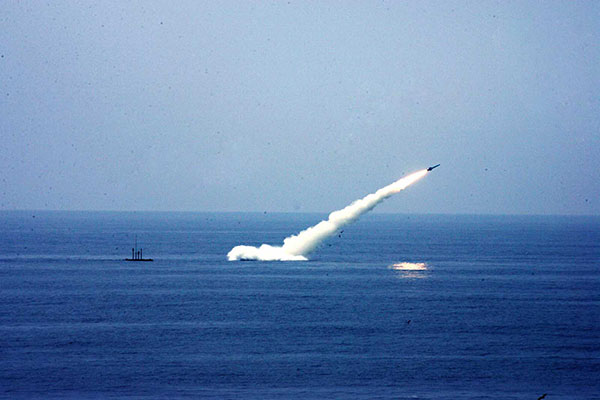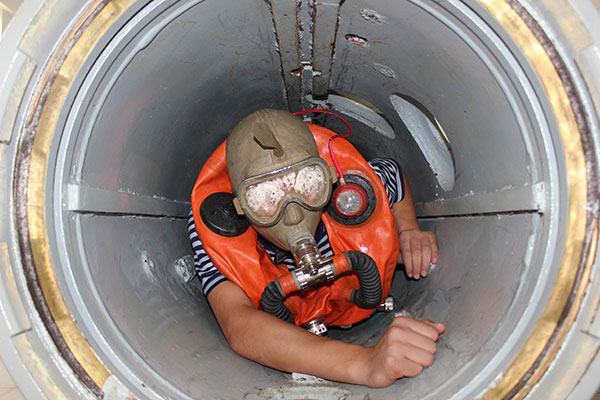
Crew members of Submarine 372, of the PLA navy’s South Sea Fleet, salute in an undated photo. [Photo by Gao Yi/for China Daily]
For Senior Captain Wang Hongli and his crew, reacting fast enough in their submarine in the abyss of the ocean is a matter of life and death.
In a recent People’s Liberation Army navy patrol mission, his team had just three minutes to save their Submarine 372 from plunging into an underwater trench thousands of meters deep.
The vessel had encountered a sudden change in water conditions, leading it to sink uncontrollably fast.
“We couldn’t control the boat’s depth despite my order to fill the ballast tanks. It fell tens of meters in less than three minutes,” Wang said.

Submarine 372 fires a missile during an exercise. [Photo by Gao Yi/for China Daily]
His crew quickly seized the little time they had, opening all the emergency air flasks within 10 seconds to fill the tanks. They managed to close more than 100 valves and related equipment in less than a minute. In two minutes, all the cabins were sealed.
The team’s swift, coordinated reaction saved everyone.
“It is not uncommon for a submarine to temporarily lose control of its depth due to the change in seawater density and undersurface current, but most of the time we can fix that by rebalancing or speeding up,” Wang, commander of an elite submarine flotilla under the PLA navy’s South Sea Fleet, recently told a news conference in a rare open house.
“But this time, the submarine was sailing in deep waters and it was sinking very fast, so if we didn’t move fast, the boat and its whole crew would have been pulled into the abyss in a very short time.”
One of the vessel’s pipes in the main engine cabin was also damaged by the increased water pressure, resulting in an influx of seawater and the main engine losing its power.

A sailor tries to escape from a pipeline during an emergency response drill. [Photo by Zhou Yancheng/ or China Daily]
Ma Ze, a staff officer from the PLA navy headquarters in Beijing who took part in the mission, explained how serious the situation was.
“Everyone who has served on a submarine knows that three situations pose the most dangerous threats to a boat — uncontrollable sinking caused by loss of buoyancy, influx of seawater and equipment catching fire. Submarine 372 suffered from two of them at one time, which truly presented a life-or-death situation for its crew.”
Professor Liu Guijie from the Ocean University of China told the South China Morning Post: “It’s really dangerous. In this case, the water density suddenly falls and as a consequence the buoyant force would also decrease, which would make the watercraft plummet.”
Many later agreed that the crew’s escape from death was a miracle in the navy’s history.
The tough training, spirit of sacrifice and unwavering faith in teamwork were the weapons that Wang’s crew used to save themselves, he said.
Quick response
The submarine’s officers and sailors were well-trained and not overcome by panic during the emergency, Captain Yi Hui of Submarine 372 said.
Chen Zujun, the electrical equipment chief, was on duty in the main engine cabin with two of his subordinates, Mao Xuegang and Zhu Zhaowei. After hearing a bang, the three crewmen found seawater flooding the cabin. Dense fog also blurred their vision.
Chen immediately ordered crew members to close hatches and stem the leak. He shut down the main engine and other electrical apparatus in the section while Mao and Zhu struggled to fix the broken pipes.
“We couldn’t hear the instructions from the commander because it was very loud in the cabin, so we didn’t waste time waiting for orders but carried out the measures that we had practiced numerous times,” Chen said. “The procedures are in our blood.”
Lian Shicai, Submarine 372’s chief petty officer, said the training and exercises have implanted quick responses in the crew.
“We are trained to be fast in handling fires, leaks and other contingencies, and we know clearly what to do when such hazards arise,” he said.
The flotilla has also been encouraging crew members to repair malfunctioning or broken parts on their own and has given awards to those who succeed, substantially enhancing submariners’ knowledge and capabilities, said the vessel’s power chief, Xie Baoshu.
“From the start of each year, we would make a comprehensive and systematic plan for the training and drills for the whole year. Experts from the submarine academy and related areas are invited to give lectures to the submariners or help us address problems,” Yi said.
“Every crew member, including the captain and political commissar, must attend and pass theoretical and practical tests for their posts.”
The flotilla also holds competitions on skills and emergency response on a regular basis, urging heads of each submarine to keep strengthening crews’ combat readiness, he said.
Mission priority
After Submarine 372 surfaced following its emergency, senior officers on board decided not to report the incident to the South Sea Fleet headquarters until the vessel completed its mission.
“At first, I was not sure whether the boat and its crew could carry on the mission because the vessel had been flooded by seawater. A lot of equipment had malfunctioned and all the men were exhausted after nearly three sleepless days of repair,” Yi said.
“But the officers and sailors insisted on completing the patrol while the equipment was gradually being restored, giving us more confidence to carry out the mission.”
Wang also found the submariners facing another major challenge after the emergency — dealing with foreign military ships and aircraft.
Submarine 372 was driven by one electric motor because its main engine was being repaired. It continued to maneuver underwater and took the opportunity to forge its combat capability, he said.
“The rivals were coming for us but our sailors didn’t flinch ... I was thinking that, since they (foreign navies) were ‘generous enough to give us a combat training opportunity for free, we shouldn’t waste it,” Wang said.
The submarine successfully broke through several rounds of encirclement and pursuits by foreign navies and continued its patrol in the next days before returning to base.
Presidential awards
Zhi Tianlong, president of the PLA Navy Submarine Academy, said Wang and his men’s handling of the incident was exemplary.
“They succeeded in defusing such a complicated and grave emergency. Their performance was excellent and it will be written into our textbooks. The navy will promote their experience to all submarine forces,” said Zhi, who has served with the navy’s submarine units for more than three decades.
To further recognize the crew’s courage and capability, Senior Captain Wang was given a first-class military service citation by President Xi Jinping, who is also chairman of the Central Military Commission, in September, while the PLA navy gave the crew a first-class merit citation, which is rare in peacetime.
Admiral Wu Shengli, commander of the PLA navy, said at the award ceremony that the Submarine 372 crew’s feat will inspire all its servicemen to honor their duties and build a strong navy.
The flotilla organizes long-distance patrols every year, and these operations will continue to expand in distance and duration, with submarines continuing to explore new depths, Wang said.
“We value every experience we get in our operations. Crew members are required to review and learn from their performance and missions, so that they can constantly improve,” he said.
Vessel steering chief Zhao Manxing said every submariner in his flotilla aspires to adventure and honor.
“Fighting windstorms and billows is what a man should do in his youth, so I joined the submarine fleet,” he said.
“We don’t believe in fear and hardship.”
